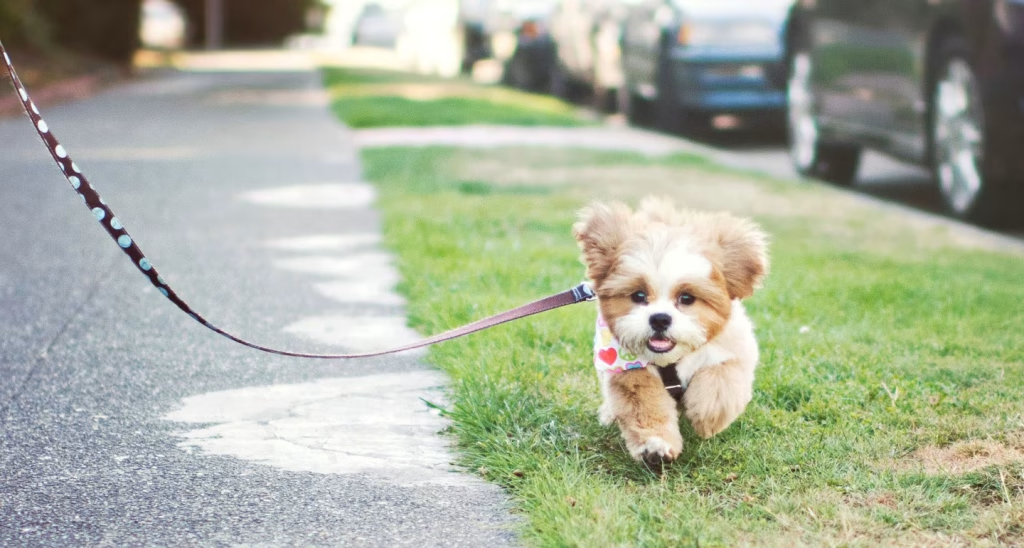So, you’ve got a new pup bouncing around your house like a furry tornado and you’re thinking, “When can we take this little rascal out for a proper walk?”
Let’s be real. Between the zoomies, the chewed-up flip-flops, and the potty mishaps, getting your puppy leash-trained feels like the next big milestone.

But the timing? That’s where most people get a bit stuck.
Starting Leash Time Indoors First
Most puppies can start getting used to a collar or harness and a leash right around 7 to 8 weeks old. Not for street walks just yet, but for practice indoors or in your yard.
Think of it like a toddler wearing shoes for the first time. You wouldn’t toss them straight into a marathon, right? Same deal with puppies.
The goal is to let them feel the leash, walk around with it dragging behind, and get used to the slight tension without freaking out.
Some pups may sit and pout. Others will try to bite it like it personally offended them. Totally normal.
When It’s Safe to Hit the Pavement
Here’s the thing. You’ve got to wait until your puppy has had at least two rounds of vaccinations before heading out for public walks. For most pups, that’s around 12 to 16 weeks.
Vets say it because young pups are vulnerable to some nasty stuff like parvo or distemper, especially in places where loads of dogs walk and do their business.
So if you’re an eager beaver, stick to safe zones like your backyard or a clean patio until your vet gives the green light.
Quick tip? Ask your vet during your puppy’s vaccine check. They’ll let you know when the coast is clear.
Baby Steps, Not Hiking Adventures
Once your pup is cleared for outdoor action, take it slow. A five-minute walk might be plenty at first. Puppies tire quickly, and overdoing it can lead to joint issues, especially with larger breeds.
A good rule of thumb? About five minutes of walking for every month of age. So a three-month-old pup might handle a 15-minute stroll just fine. And if they flop down mid-walk and refuse to budge? Scoop them up. They’re done for the day.
You’re not building a marathon runner here. You’re building trust and good habits.
Making the Leash Feel Like a Good Thing
Let’s be honest. Not all puppies are leash lovers right away. Some act like they’ve been wronged by this strange tether. The key is making it feel like a game, not a punishment.
Try this: clip the leash on during playtime or before meals. Let them drag it around the house. Reward calm walking with treats or silly praise. The goofier you sound, the more they’ll love it.
One family I know tied the leash around a belt loop while making dinner so their pup learned to follow them calmly without pulling. No pressure, no drama. Just tagging along like a shadow.
What If They Pull or Panic?
Ah, the classic pancake dog. The moment you step outside and they freeze like a statue or start digging in the opposite direction. That’s not stubbornness, that’s nerves.
New smells, weird sounds, people with umbrellas, it can all be a bit much.
Try keeping walks short, in quiet spots, and bring the tastiest treats you own. If they pull, stop and wait. No yanking. Just wait it out.
When they ease up, reward and keep moving. It’s more about learning how to walk with you than just walking.
And if they’re too anxious, no shame in going back to the yard and trying again next week. It’s not a race.
Different Dogs, Different Timelines
Not every puppy develops at the same pace. Some confident little nuggets strut down the block at three months like they own the place. Others take until five months just to sniff past the driveway.
Breed matters, too. Hounds love to sniff and pull. Herding breeds might focus better early. Toy breeds can be more cautious. Rescue pups might need time to adjust if they’ve had a rocky start.
So don’t compare your pup to the neighbor’s golden retriever who walks off leash already. Focus on progress, not perfection.
Protecting Floors, Patience, and Furniture
Let’s talk gear. Skip retractable leashes at first. They give too much freedom too soon and can be hard to control. Go for a basic four or six-foot leash with a comfy grip.
Harness or collar? For young puppies or breeds with delicate throats, a soft harness is usually kinder. Less pulling, less coughing.
Oh, and keep a stash of old towels near the door for muddy paws. Trust me.
Bringing the Family In
If you’ve got kids itching to walk the puppy, make sure they learn the basics first. A puppy who pulls or panics can be too much for a young child to handle safely.
Start by having the child walk beside you while you hold the leash. When the pup is more reliable, they can take turns under supervision. It becomes a shared job, and it teaches kids a bit of patience too.
When Things Feel Stuck
If after a few weeks your puppy is still terrified of the leash, pulling like a sled dog, or refusing to walk, don’t be afraid to ask for help. A positive reinforcement trainer can work wonders.
Even a single session can give you simple tips that make a big difference. It’s not a failure, it’s just smart planning.
Wrapping Up
Walking your puppy on a leash isn’t just about exercise. It’s about trust, safety, and slowly building their confidence out in the world.
Start indoors, be patient, go at their pace, and make it fun. Whether you’re walking through quiet streets or dodging squirrels at the park, the journey matters more than the timeline.
Every dog learns at their own speed. Yours will get there.
What’s your puppy’s walking style, the confident explorer or the nervous pancake?